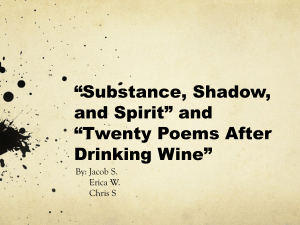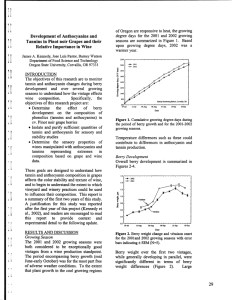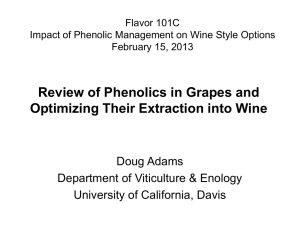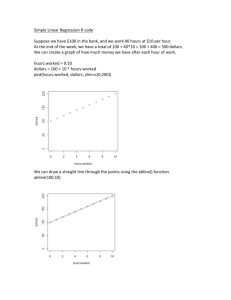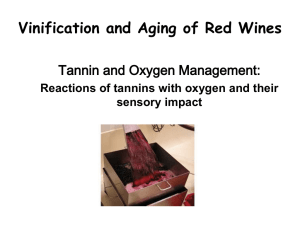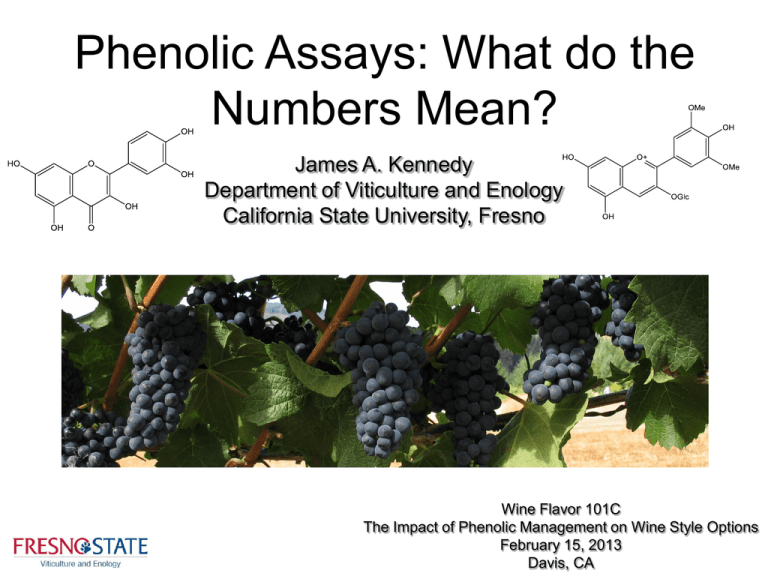
Phenolic Assays: What do the
Numbers Mean?
James A. Kennedy
Department of Viticulture and Enology
California State University, Fresno
Wine Flavor 101C
The Impact of Phenolic Management on Wine Style Options
February 15, 2013
Davis, CA
Outline
• Phenolic compounds
– General wine phenolic composition
– Specific compounds in grapes/wine and importance
• Analyzing for phenolics
– Non-specific
– Specific
– Combination
• Using analytical information
– Fruit development
– Fermentation/Maceration
– Aging
• Future trends
Wine Composition-Phenolics
Waterhouse, A., Ann. N.Y. Acad. Sci. 2002, 957:21-36
Volatile Phenols
4-ethylphenol
• Low molecular weight, volatile
• Associated with Brettanomyces sp. Infections
– 4-ethylphenol (4-EP), 4-ethylguaiacol (4-EG)
– Increase in proportion of 4-EG related to spiciness
– >500 g/L generally detectable, 3000 g/L high Brett.
• Smoke tainted wines
– Guaiacol, 4-methylguaiacol, 4-EP, 4-EG
– Glycosides (non-volatile) also present
• Analyzed by GC-MS or HPLC
• Concentrations
– Clean wine: not detectable
– Problematic wines: free guaiacol >200 g/L
Hydroxycinnamic Acids
t-caftaric acid
• Present in all wines (present in the mesocarp)
• Produced as tartaric acid esters
• Major hydroxycinnamic acid ester is trans-caftaric acid
ester
• Tartaric acid portion hydrolyzed over time
• Vicinal dihydroxy phenol susceptible to oxidation
– Glutathione adduct of caftaric acid (GRP) can provide
information on oxidation of must/juice
• Useful for white wine production
• Involved in white wine color
Stilbenes
t-resveratrol
• Belong to a group of compounds called phytoalexins
(antimicrobials)
– Upregulated in grapes in response to fungal infection
•
•
•
•
trans-resveratrol most abundant
Glycosides (piceids) and polymers (viniferins) also found
Provides indication of “rot” presence
Some monitor for labeling purposes
– “wine and health”
Catechins
• Other names:
(-)-epicatechin
– flavan-3-ol monomers, (+)-catechin, (-)-epicatechin
• Almost exclusively seed-derived
• Ratio of [catechin] to [tannin] can provide information on
relative seed extraction
• High concentrations suggestive of bitterness
• Concentration declines with fruit maturity
– Amount relative to extractable tannin concentration also declines
Flavonols
quercetin
• Present as glycosides in grape, partially cleaved in wine
• Concentration in grapes provides information on fruit
exposure
– Indirectly related to exposure and flavor
• Concentration in wine indicates skin extraction (can be
useful in white wine production).
• Poorly soluble in wine
– Low color and low tannin wines, with high flavonol
concentrations are prone to physical instability (e.g.:
Sangiovese)
Anthocyanins
malvidin-3-glucoside
• Responsible for initial color in red wine
• Higher concentrations associated with darker red wine
• Several equilibrium forms
– pH sensitive
– Colored and non-colored forms
– Red form is not the major component
Tannins
• Other names:
– Proanthocyanidins, procyanidins, prodelphinidins,
condensed tannins, leucoanthocyanidins
•
•
•
•
•
•
Responsible for astringency in red wine
procyanidin B2
Found in skin, seed, pulp and stem tissue
Pulp tannin generally not present in wine
Stem tannin present only when extracted
Concentration related to perceived astringency
Lower molecular weight tannins (less than 600 MW)
considered bitter
• Considered to be essential for long term color stability in
red wine.
Pigmented Tannin
• Other names:
– Pigmented polymer, polymeric color, polymeric
anthocyanins
• Stable form of red wine color
• Generally thought to be a softening component of red
wine astringency
Other Phenolic Products
• Generally of interest from mouthfeel
and color stability standpoint.
• Active area of research
– Structure identification
– Sensory relevance
oxidation products
vitisin A
acetaldehyde – vitisin B
decarboxylated hydroxycinnamic acids – pinotins
vinylcatechin-vitisin A - portisins
For phenolic analytical information
to have value, results should relate
(directly or indirectly) to perception.
Analyses and Maturity/Management
• White Wines
– Grapes
• Flavonols
• Smoke taint
• Catechin/tannin
– Fermentation/Maceration
• GRP/caftaric
• Catechins (solids contact)
• Polymer at 360 nm
– Aging
• Red Wines
– Grapes
•
•
•
•
•
Catechin/tannin
Flavonols
Anthocyanins
Phenolic extractability
Smoke taint
– Fermentation/Maceration
• Catechin/tannin
• Anthocyanins/Pigmented tannin
• Tannin
– Aging
•
•
•
•
Flavonols (phys. stability)
Anthocyanins/Pigmented tannin
Tannin
Volatile phenols
Analytical Methodology
- non specific • UV/Vis absorbance spectrophotometry
–
–
–
–
Relates absorbance information to phenolic composition
UV/Vis of wine at single wavelength (360, 420, 520, 620 nm)
Folin Ciocalteu
Disadvantages
• With exception of red color, measurements have historically lacked
specificity
– Advantages
• Generally rapid and cheap
• Pretreatment can provide specificity (e.g.: protein precipitation)
– Subsequent direct UV/Vis measurement at multiple wavelengths can provide specificity
– Useful for color and tannin measurements
Red Wine Absorbance
Somers, 1998
Analytical Methodology
- specific -
• Specific phenolic compound(s) are separated
from the matrix and quantified
• Volatile phenols: gas chromatography
– 4-EP, 4-EG . . .
• Non-volatile phenols: HPLC
– Hydroxycinnamic acids
– Flavonoids
• Advantages
– Excellent specificity
• Disadvantages
– Expensive
Phloroglucinol-Subunit
Adduct Analysis
OH
OH
O
OH
(+)-catechin
OH
OH
OH
HO
OH
OH
O
OH
(-)-epicatechin
OH
OH
OH
OH
OH
OH
HO
OH
O
OH
OH
(-)-epigallocatechin
OH
OH
HO
OH
OH
OH
O
OH
(-)-epicatechin-3-O-gallate
OH
O
OH
OH
O
HO
OH
OH
OH
OH
Kennedy and Jones, J. Agric. Food Chem., 2001
Skin Proanthocyanidins
Seed Proanthocyanidins
400
Day 4
300
200
100
51%
Skin
54%
Skin
51%
Skin
50%
Skin
53%
Skin
Proanthocyanidin concentration (mg/L)
Proanthocyanidin concentration (mg/L)
Berry Integrity:
Skin and Seed Tannin Extraction
0
Skin Proanthocyanidins
Seed Proanthocyanidins
400
300
200
100
45%
Skin
71%
Skin
54%
Skin
20
40
60
80
100
0
20
40
Skin Proanthocyanidins
Seed Proanthocyanidins
400
79%
Skin
73%
Skin
72%
Skin
300
60
80
100
% Crushed berries
200
59%
Skin
50%
Skin
Day 9
0
Proanthocyanidin concentration (mg/L)
% Crushed berries
Proanthocyanidin concentration (mg/L)
69%
Skin
61%
Skin
0
0
100
Day 5
Skin Proanthocyanidins
Seed Proanthocyanidins
400
56%
Skin
63%
Skin
55%
Skin
53%
Skin
300
51%
Skin
200
100
Day 17
0
0
20
40
60
% Crushed berries
80
100
0
20
40
60
80
100
% Crushed berries
Cerpa-Calderon and Kennedy, J. Agric. Food Chem., 2008
Wine Analysis:
Using HPLC-Based Data
catechin
tannin
polymeric
anthocyanins
total
catechin
anthocyanins tannin ratio
A
23 Oct
6
799
51
1097
0.01
B
25 Oct
7
621
32
1128
0.01
1 Nov
19
1072
51
944
0.02
24 Oct
35
390
23
925
0.09
26 Oct
70
888
39
1003
0.08
1 Nov
92
1313
58
809
0.07
C
10 Brix
Combination
• Combines simplicity of UV/Vis absorbance, with
specificity
• Has been very useful in assessing tannins in red wine
•
Measurement based upon precipitating tannins from solution and measuring
absorbance of wine before and after precipitation
– Measurement of absorbance at multiple wavelengths
•
Relating to precipitation has resulted in correlation of UV/Vis absorbance
information to tannin concentration
–
–
Enartis/Vinquiry: MCP
Wine X-ray: A-H
22
23
Your samples
Comparison samples
24
Tannin: Napa Valley Cabernet
Future Trends
• Phenolic structure-relationships are reasonably
well developed
• Access to analytical information is increasing
– In house: UV/Vis spectrophotometry
– Analytical labs: Enartis/Vinquiry, ETS Labs, Wine
Xray
• Challenges
– Reduce cost and increase throughput further
– Astringency quality in vineyard and winery
Tannin-Protein Interaction
Most analytical methods
measure tannin
concentration/composition
and use information to
predict astringency
Tannin Response to Temperature
Barak and Kennedy, Anal. Chem., In Review
Tannin Response to Temperature
Barak and Kennedy, Anal. Chem., In Review
Tannin: Interaction vs. Size
seed
skin
CS2010
CS2012
Regression lines
- H, kJ/mol
Increasing “grippiness”
100
10
1
11.0
11.5
12.0
12.5
13.0
13.5
14.0
14.5
15.0
GPC Retention, min
Decreasing Tannin Size
Barak and Kennedy, Anal. Chem., In Review
Acknowledgements
UC Davis
Anita Oberholster
Linda Bisson
Kay Bogart
Analytical Laboratories
AWRI
Paul Smith
Enartis Vinquiry
John Katchmer
ETS Labs
Gordon Burns
Steve Price
Funding
American Vineyard Foundation



